Why let platform fees eat into your profits?
Affiliate marketing has become an essential strategy for businesses wanting to reach new audiences and drive growth.
It’s a powerful tool that allows you to tap into the networks of others, greatly expanding your reach without the need for massive advertising budgets. However, many businesses surrender a hefty chunk of their returns to platform fees.
What if you could keep more of those profits by running your own affiliate program? This guide will provide the knowledge and tools to help you do just that, enabling you to maintain control, build stronger relationships with your affiliates, and ultimately, keep more of your hard-earned revenue.
Affiliate Marketing and its Benefits
At its core, affiliate marketing is a performance-based business model where external partners, known as affiliates, are rewarded for driving traffic or transactions to your business.
Affiliates use their own channels – whether that be a blog, social media page, or an email newsletter – to promote your product or service.
Each time a sale is made or a specific action is completed as a result of their referral, the affiliate earns a commission.
Here are some key benefits of running your own affiliate program:
- Increased Exposure: Affiliates can help your products or services achieve higher visibility on the web, reaching potential customers you might not have been able to target.
- Cost-Effective: You only pay when a desired action (like a sale) is completed, making this a low-risk, high-return marketing strategy.
- Boosted Sales: By leveraging the audiences of your affiliates, you can significantly increase sales.
- Improved SEO: More links to your website can improve your search engine rankings, leading to more organic traffic.
- Strengthened Customer Trust: Affiliates who are trusted by their audience can transfer some of that trust to your brand, enhancing your reputation and credibility.
- More Backlinks: Affiliates’ links to your website can also improve your SEO by creating more backlinks, which help search engines recognize the relevance and authority of your site.
Now that you’ve learned about the benefits of running your own affiliate program, the next step is to understand how to build it yourself so you don’t have to pay third-party platform fees.
Using Third-Party Affiliate Platforms – A Double-Edged Sword
Using third-party affiliate platforms can be tempting for businesses new to affiliate marketing.
These platforms simplify the setup, management, and tracking of your affiliate program. They offer access to a large network of potential affiliates, automated payment systems, and detailed analytics for monitoring your program’s success.
However, there’s a downside to this convenience – platform fees. These fees, which are a percentage of your profits, can eat into your revenue. The amount you pay varies depending on the platform and can be significant, especially for high sales volumes. These additional costs, along with the commission you pay to your affiliates, can significantly impact your profits.
Also, using third-party platforms limits your ability to develop direct relationships with your affiliates. This dependency can hinder the growth and efficiency of your marketing efforts.
If you’re willing to put in the effort and want to maximize profits, running your own affiliate program is a more cost-effective option. In the following sections, we will guide you through the process of setting up your own program and show you how it can save you money.
Setting up Your Own Affiliate Program
The easiest way to set up an affiliate program is to use a WordPress plugin. I recommend AffiliateWP, one of my own brands that’s built to help small businesses have the same advantages of big enterprises.
Here’s how to go about it.
Install AffiliateWP
You need to have a WordPress site and most businesses do. If you want reasons for using WordPress, here’s a helpful post.
To install AffiliateWP, go to the website and purchase a plan that suits your needs. Once you do that, you’ll get an important welcome email with the latest version of AffiliateWP and your license.
Head to Plugins and Upload your new plugin. Activate it and you’re good to go. A step-by-step guide doesn’t fit here, so check out this detailed post for installing and activating it.
You should know that AffiliateWP will do everything a third-party platform will do for you. And you just pay a 1-time yearly subscription. You retain more profits than before and will make back the price in no time. Also, many affiliate partnership sites have hidden fees that won’t make the cost worthwhile, so your best best is to invest in the AffiliateWP plugin.
Configure Your Affiliate Program Settings With the SetUp Wizard
Now, I recommend using the easiest way to launch your affiliate program: by using the Setup Wizard.
Hover over the AffiliateWP plugin in the left panel on your WordPress dashboard. Go to Settings. At the bottom find Launch Setup Wizard and click on it.
The setup wizard will start by asking you to add your license key which will be in your welcome email.
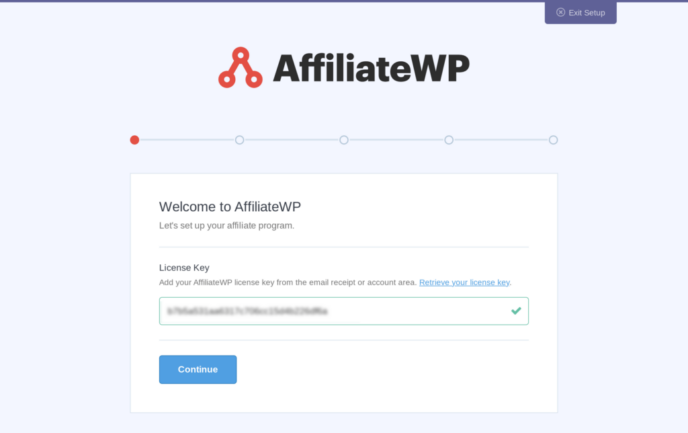
Choose the right integration for your setup. If you have an online course, WooCommerce store or use PayPal, this will make it easy to integrate and track everything.
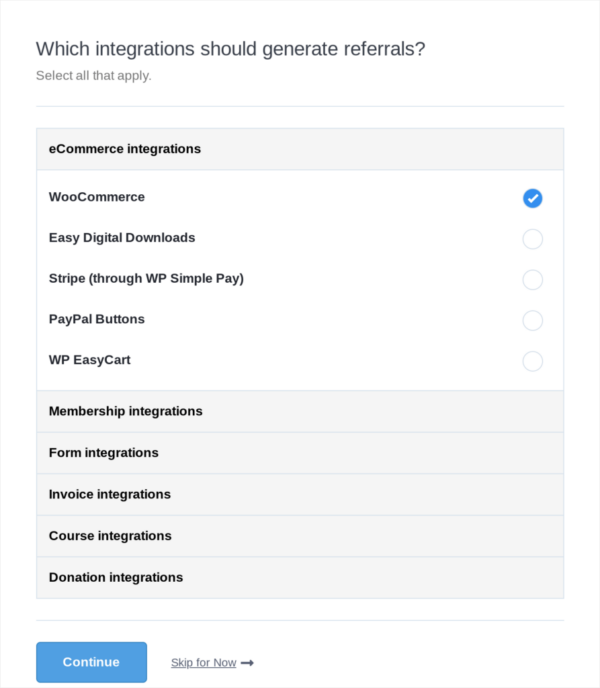
Now choose the details about your affiliate program i.e the currency and percentage of commissions your affiliates get.
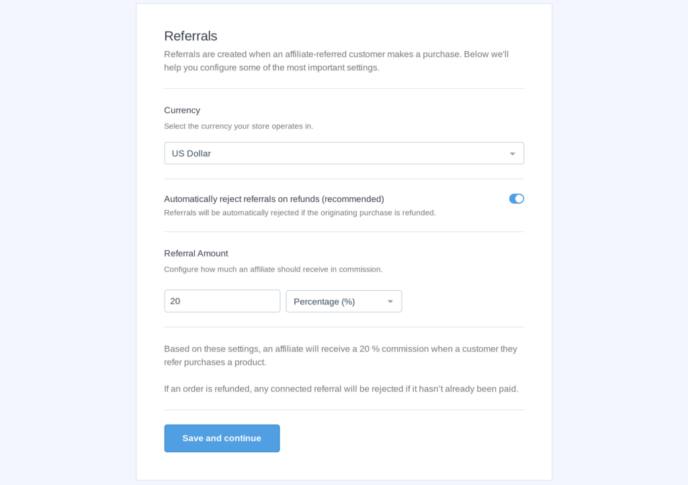
You can also add your affiliate link structure and cookie expiration date i.e. for long your site remembers the visitor’s affiliate referral. Most brands keep it at 30 days.
Build Your Affiliate Area
You now can set up the registration page and form so your affiliates can sign up.
Create a new Page; for example, name it: Affiliate Area.
Link this page to the Affiliate Area filed in the General tab.
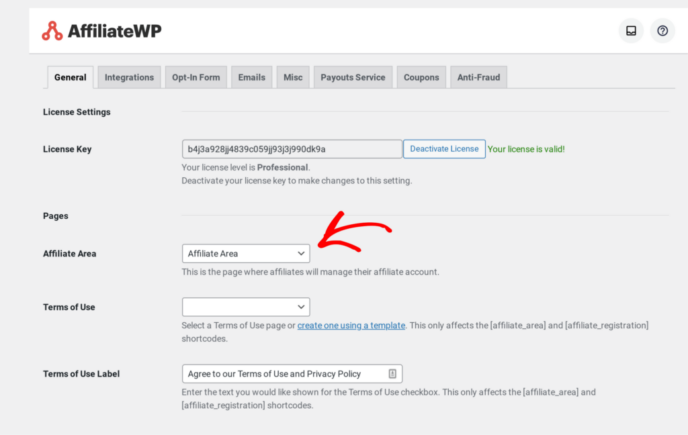
Customize your registration form on this page to vet your affiliate marketers.
Your affiliate partners can sign up and then use the same page for logging in. When they do log in, they reach a gorgeous dashboard with all the important details.
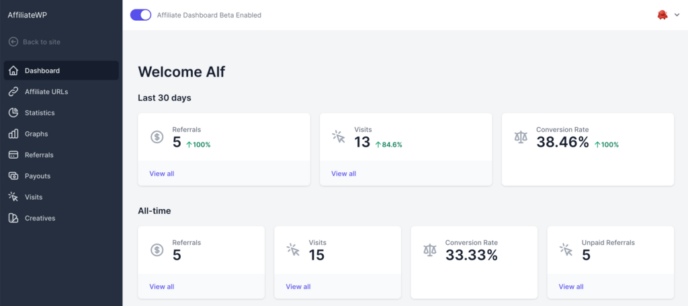
You can customize this area even more if you like with drag and drop options featured in AffiliateWP’s settings.
Manage and Grow
From here, all you have to do is manage your affiliates from your Affiliates page.
You can access real-time metrics for earnings, payuts, referrals, and visits. Manage each affiliate by clicking on their name.
Want to make your affiliate program even more enticing, then you should use Add-ons like:
- Personalized landing pages
- Affiliate Portals
- Vanity coupon codes
There are many more addons in AffiliateWP’s toolkit to boost your earnings and referrals, so you want to check them out.
Set up Payouts
Navigate to the AffiliateWP settings and access the Payouts Service tab.
There, you’ll find a link to connect to the Payouts Service. Fill out the required form with your information and return it to the Payouts Service tab. Enable the Payouts Service by checking the appropriate box.
Once you’ve completed the sign-up process for the payouts service, your new affiliates can conveniently register for direct payments to their bank accounts by accessing the Settings tab in their affiliate area.
With your affiliates now registered and their payment details provided, you’re all set to boost your affiliate sales and grow your program.
Over to You
Running your own affiliate program is a smart and cost-effective way to grow your business. By using AffiliateWP, you not only save on platform fees but also have full control over your program and can build direct relationships with your affiliates.
Don’t let third-party platforms limit your potential for success. Follow the steps outlined in this guide and watch as your profits soar as you generate passive income and stay independent.
–
Syed Balkhi is an award-winning entrepreneur and online marketing expert. He is the co-founder of OptinMonster, WPBeginner, MonsterInsights, and WPForms.
from John Chow dot Com https://ift.tt/4K8NgrR
via IFTTT
No comments:
Post a Comment